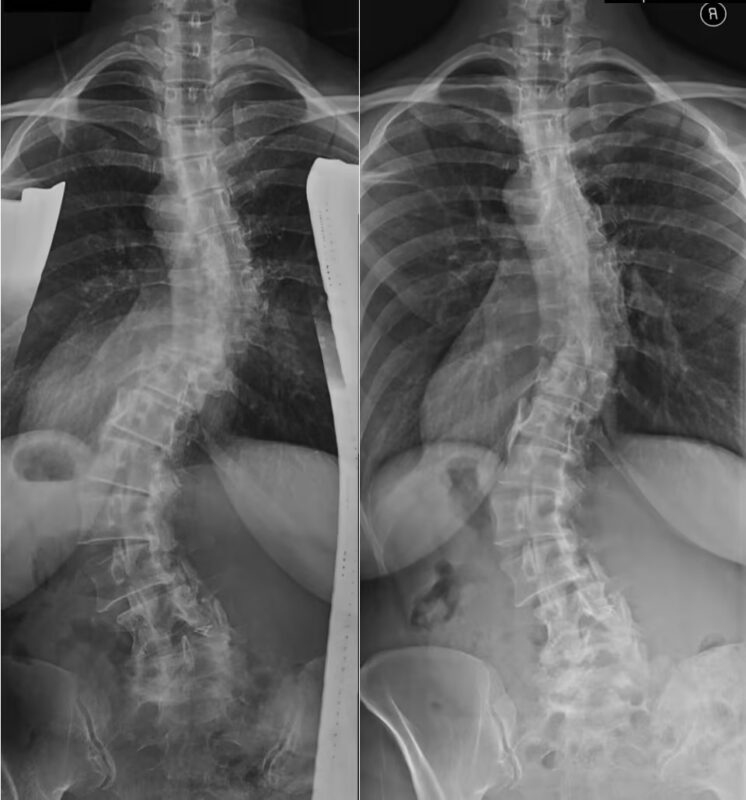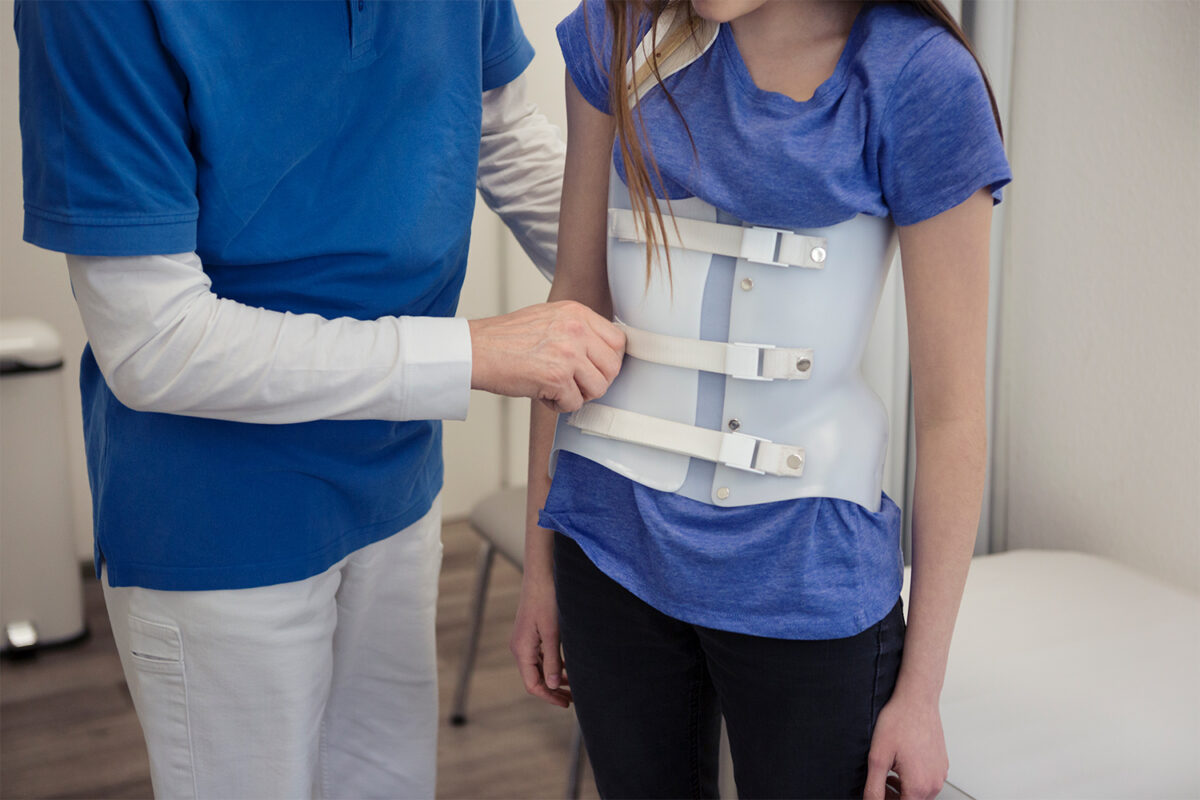Scoliosis is a medical condition characterized by an abnormal lateral curvature of the spine. While mild cases are generally manageable and do not pose significant health risks, severe scoliosis can lead to life-threatening complications if not appropriately treated. In this article, we delve into the types, causes, identification of severe scoliosis, its potential complications, and the treatment options available for managing this condition.

Compreender os diferentes tipos e causas de escoliose
Scoliosis can be classified into several categories based on its cause and onset:
- Idiopathic Scoliosis: The most common type, accounting for 80% of cases, where the exact cause is unknown but likely involves genetic factors .
- Congenital Scoliosis: Present at birth, resulting from malformations in the spine during fetal development .
- Neuromuscular Scoliosis: Associated with neuromuscular conditions like cerebral palsy or muscular dystrophy, where muscle imbalance contributes to spinal curvature .
- Escoliose degenerativa: Occurring in older adults due to age-related spinal degeneration, which can lead to curvature .
Identifying Severe Scoliosis
Severe scoliosis is generally defined by a Cobb angle exceeding 40-50 degrees. Early detection is critical to prevent serious complications. Routine screenings during adolescence are vital since this is the period when scoliosis typically develops. Diagnostic methods such as X-rays, MRI, and CT scans are employed to assess spinal curvature and guide treatment decisions .

Is Scoliosis Life Threatening? Life-Threatening Complications of Severe Scoliosis
Severe scoliosis can lead to multiple life-threatening issues, primarily affecting the respiratory, cardiovascular, and neurological systems.
Respiratory Complications
One of the most concerning aspects of severe scoliosis is its impact on lung function. As the spine curves abnormally, the rib cage may compress the lungs, leading to reduced lung capacity, difficulty breathing, and increased risk of infections . Studies show that patients with severe scoliosis often experience compromised pulmonary function, which can lead to respiratory failure in extreme cases .
Cardiovascular Risks
In severe cases, the spinal curvature can place pressure on the heart and major blood vessels, leading to reduced cardiac output and increased risk of cardiovascular complications, including arrhythmias and heart failure . Such impacts are especially concerning as they can exacerbate other health issues, compounding the overall health risks.
Neurological Implications
Severe scoliosis can also have neurological consequences due to the compression of the spinal cord or nerve roots. This can manifest as chronic pain, numbness, muscle weakness, or in extreme cases, paralysis and loss of bladder or bowel control .
Impact on Quality of Life
The physical limitations, chronic pain, and psychological toll associated with severe scoliosis can significantly diminish a patient’s quality of life. Studies indicate that individuals with severe scoliosis often experience depression, anxiety, and social isolation due to visible deformities and functional limitations .
Surgical Treatment Options
For severe scoliosis, surgical intervention is often necessary to correct spinal alignment and prevent further complications. The primary surgical procedure is spinal fusion, which involves fusing the vertebrae using metal rods, screws, or hooks to stabilize the spine and prevent further progression . Surgical outcomes are generally favorable, with most patients experiencing improved posture and reduced pain, although risks such as infection and hardware failure exist.
Non-Surgical Treatment Approaches
Non-surgical treatments are typically considered for moderate scoliosis or patients not suited for surgery. These may include:
- Braçadeiras: Often used in growing adolescents to halt curve progression .
- Fisioterapia: Exercises focused on core strengthening and posture improvement .
- Controlo da dor: Medications and supportive care to alleviate symptoms in cases where surgery is not an option .

Conclusão
Severe scoliosis poses life-threatening risks due to its potential to compromise respiratory, cardiovascular, and neurological functions. Early detection and intervention are crucial to prevent these complications. Surgical treatments, such as spinal fusion, are typically necessary for severe cases, while non-surgical options can be effective for managing symptoms and halting progression in certain scenarios. By understanding these risks and treatment options, patients and healthcare providers can work together to achieve the best possible outcomes.
Referências
- Halpern JL, Daly R, Marciano C, et al. “Comparison of bracing with surgery for treatment of adolescent idiopathic scoliosis.” Deformação da coluna vertebral. 2018;6(4):267-275. doi: 10.1016/j.jspd.2017.10.001.
- Weinstein SL, Dolan LA, Wright JG, Dobbs MB. "Efeitos do aparelho em adolescentes com escoliose idiopática". N Engl J Med. 2013;369(16):1512-1521. doi: 10.1056/NEJMoa1307337.
- Hedequist DJ, Emans JB. “Congenital scoliosis: a review and update.” J Pediatr Orthop. 2007;27(1):106-116. doi: 10.1097/01.bpo.0000248569.45965.79.
- Miller NH. “Cause and natural history of adolescent idiopathic scoliosis.” Orthop Clin North Am. 1999;30(3):343-352. doi: 10.1016/S0030-5898(05)70093-0.
- Ploumis A, Transfledt EE, Denis F. “Degenerative lumbar scoliosis associated with spinal stenosis.” Lombada J. 2007;7(4):428-436. doi: 10.1016/j.spinee.2006.07.017.
- Lonstein JE, Carlson JM. "A previsão da progressão da curva na escoliose idiopática não tratada durante o crescimento". J Bone Joint Surg Am. 1984;66(7):1061-1071. doi: 10.2106/00004623-198466070-00008.
- Newton PO, Yaszay B, Upasani VV. “Surgical treatment of adolescent idiopathic scoliosis.” Lancet. 2016;388(10058):2768-2776. doi: 10.1016/S0140-6736(16)31527-8.
- Koumbourlis AC. “Scoliosis and the respiratory system.” Paediatr Respir Rev. 2006;7(2):152-160. doi: 10.1016/j.prrv.2006.03.008.
- McMaster MJ, Glasby MA. “Scoliosis: respiratory complications.” J Bone Joint Surg Br. 2011;93-B(11):1481-1485. doi: 10.1302/0301-620X.93B11.26865.
- Kuru T, Yılmaz H, Kocaman G, et al. “Evaluation of cardiovascular status in scoliosis patients.” Clin Spine Surg. 2018;31(4). doi: 10.1097/BSD.0000000000000632.
- Cheung JPY, Luk KDK. “Neurological involvement in scoliosis.” J Orthop Surg Res. 2019;14(1):41. doi: 10.1186/s13018-019-1078-7.
- Danielsson AJ. “Health-related quality of life in patients with adolescent idiopathic scoliosis: a matched follow-up at least 20 years after treatment with brace or surgery.” Eur Spine J. 2009;18(3):386-393. doi: 10.1007/s00586-008-0869-5.
- Weiss HR, Moramarco M. “Spinal fusion for scoliosis: what is the evidence?” Prospects in Spinal Surgery. 2013;24(6):515-526. doi: 10.1016/j.jspd.2019.06.016.
- Negrini S, Donzelli S, Aulisa AG, et al. "Diretrizes SOSORT 2016: tratamento ortopédico e de reabilitação da escoliose idiopática durante o crescimento". Scoliosis Spinal Disord. 2018;13:3. doi: 10.1186/s13013-018-0175-8.
- Bridwell KH, Lenke LG, Baldus C. “Comprehensive surgical management of severe spinal deformity in adults.” Lombada (Phila Pa 1976). 1999;24(24):2514-2524. doi: 10.1097/00007632-199912150-00010.

